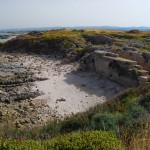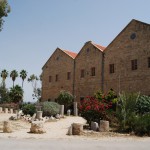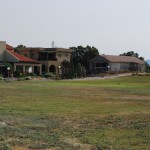Hof Dor, National Park Tel Dor (Israel)
Dor (Hebrew — דוֹר) is an ancient Canaanite city-port, which is located in Israel on the Mediterranean coast, between the cities of Haifa and Tel-Aviv. The name of the city has been associated with the Dorians1.
From the direction of the sea, Dor lies between three little islets that form a small lagoon. From the side of the dry land, Dor is situated on a narrow headland of the fertile SharonValley, between Mount Carmel and the Mediterranean Sea. The first mention of Dor is found in the documents that belong to the time of pharaoh Ramses II’s reign (1304—1237 before our era), but there are indirect evidences that ancient people lived in this area as far as 30 thousand years ago.
In the 11th and 10th centuries BE, on the site of Dor there was a settlement with characteristic for that period houses that were built around an enclosed central courtyard. Ceramic fragments suggest bountiful economic connections between the Canaanites, who inhabited the city, and ancient Egypt and Cypress.
In the second half of the 10th century before our era, the city was inhabited mostly by Phoenicians, and trade connections were oriented predominantly toward Greece and Sardinia. In the Bible Dor is mentioned as one of thirty one cities, conquered by Joshua, but the cultural life of the city remained Canaanite-Phoenician, with ceramics that is characteristic for the north of the country, Akko region and Lebanon.
During the years of King David’s reign, Dor became a part of the David’s empire, and his son, King Solomon, gave Dor to his son-in-law Ben-Avinadav to be under his rule. Along with that, only after Solomon’s death, Dor began to change, acquiring the characteristic traits of Hebrew culture.
Under the Assyrian kings Tiglath-Pileser III and Esarhaddon, Dor played an important role as a city-port. At the end of the Assyrian empire’s period, Dor lost its significance and even was abandoned by its citizens because of an unknown reason.
At the same time, under the Persian Empire, Dor was designated as a free economic zone together with Japho, and was declared, “The land that is rich with grain in the region of the SharonPlain.” Kings of Sidon from then on had the dominion over Dor and Japho. At that time, the street system was established in the city, which was still in use during the Greek period. Alexander the Great took over the city, apparently, without a fight, and it can be explained by the fact that the city was under the authority of Sidon’s rulers.
Under the Greek rule, the city rapidly developed, and in the course of recent excavations temples and public facilities were discovered. Dor, just like Straton’s Tower (Caesarea), was conquered and annexed by Judea during the reign of Alexander Yannai.
Dor reached the peak of its glory under the Roman Empire. Private dwellings, markets, and public facilities of that period were discovered by archeologists. The Romans supplied the city with an aqueduct, monumental gates and a theater. Nevertheless, when Caesarea was built, and after the rise of that city, Dor’s citizens gradually began to leave the settlement; and Dor virtually ceased to exist.
In the Byzantine period, Dor was not populated, and a small chapel, built at the foot of a hill, was more likely a sign of the new rulers, than actually served its parishioners. Dor was not populated all the way until the Crusaders’ times.
It is believed that in the 13th century (according to other sources, in the 12th century), on Dor’s ruins the Crusaders, who realized its advantageous strategic location, built their fortress Tantur (according to other sources, MerlCastle), which was soon after that torn down by the Mamluks.
The fact of the fortress’s presence on the site of historic Dor and generally accepted tradition among the historians to reckon this fortress as a legacy of the Crusaders’ creation is quite fervently argued today.
All the way until the rule of the Ottoman Empire, Dor had been staying desolate; and only in the second half of the 18th century, there was a village here called Tantura, on the site of which kibbutz Nahsholim and moshav Dor are located today.
Kibbutz Nahsholim was founded in 1948, after the Independence War. Today, the chief attraction of the kibbutz is its museum that bears the name Mizgaga, or the Museum of Nautical Archeology. It is housed in the building of a glass factory that was founded here by Baron de Rothschild. Baron built the factory to produce glassware for the wine industry in Zikhron Ya’akov in 1891. The museum engages in two main fields of activity – excavations at the old city of Dor and nautical archeology.
Moshav Dor is situated south of the ruins of the ancient Dor. It was founded in 1949 by immigrants from Greece as a fishermen village at the place, where at the end of 1930s, ships with illegal repatriates from Europe landed. In 1950s, repatriates from Iraq also came to live in Dor. Its area is 150 hectares; the population is 326 people (as of beginning of 2002). The main industries are: dairy cattle husbandry, poultry breeding, vegetable farming. There is a station of fishery supervision here. At Dor a monument is set to commemorate the soldiers who died in the War for Independence.
1 Dorians (old Greek - Δωριεῖς) — together Achaeans, Ionians, and Aeolians were one of the major Greek tribes. They spoke Dorian dialect of the Greek language, of which the only modern descendant is Tsakonian Greek.
According to the Greek mythology, the Dorians’ founder was Dorus, son of Hellen and nymph Orseis. According to tradition, they first lived in European Greece, near MountOlympus and MountOssa, in Thessaly region of Hestiaea, and in Doris near MountOeta. They received the lands in Central Greece (Doris region) from Heracles. Around 1100 before our era, Dorians led by the Heraclids invaded the Peloponnesus, where many regions had been already conquered by Heracles (in mythology the Dorian invasion received the name “the return of the Heraclids.”).
The materials were used from the following resources on the web:http://www.dopotopa.com;http://praisman.com;http://guide-israel.ru; http://www.eleven.co.il





